SURVIVAL IN THE SADDLE • PART 8
Welcome back to our discussion of highway hazards to motorcycles. In the previous post we had some preliminary discussion about lane choice, lane changes and other topics relative to traveling on major roads at high speeds. Today we’re going to be discussing other things to consider when riding the big roads.
This is the latest episode of the “Survival in the Saddle” series which has proven to be one of the most popular offerings here on the Roadcraft USA online resource. In previous posts we have discussed such topics as intersections, visibility, riding in the rain, dealing with parked cars and parking areas and carving up the curves on those great twisty backroads. If you’re just joining us now we invite you to go back and read these great informative articles. You’ll be a better, safer, more confident rider for your trouble.
Merging Traffic
One of the beautiful things about riding divided highways is the absence of conventional intersections. Gone are the hazards of vehicles pulling out in front of you from driveways and side streets. Absent is the potential for oncoming traffic making a left turn in front of you. Remember that sobering statistic from The National Highway Traffic Safety Administration (NHTSA): 25% of all motorcycle accidents involve a vehicle negotiating a left turn into the path of an oncoming bike.
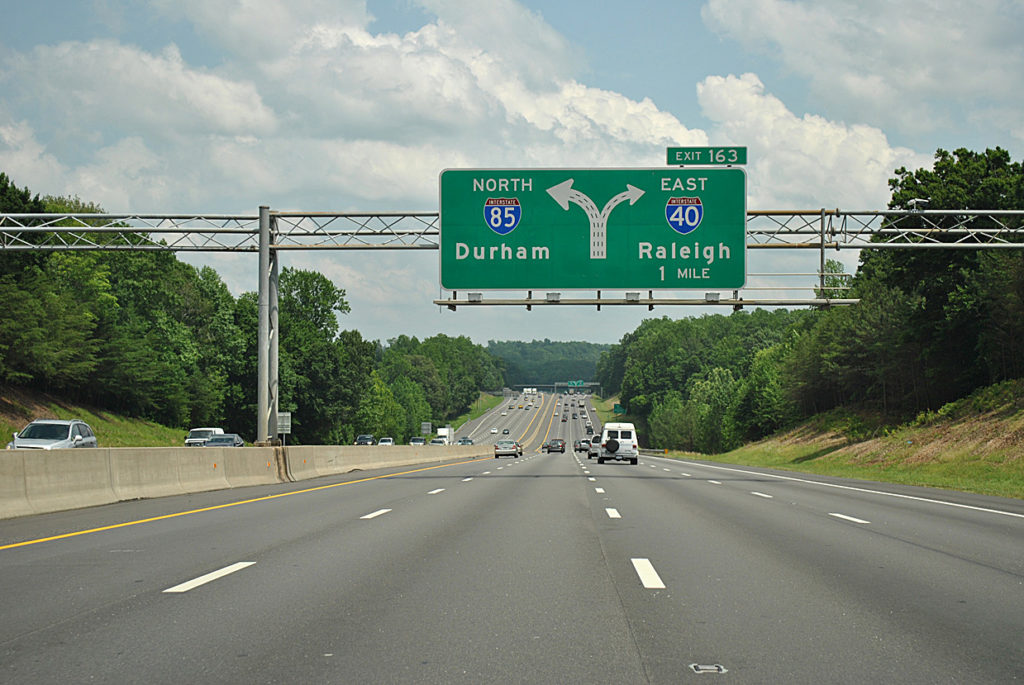
This is not to say that you’re going to be immune from confronting other vehicles whose intentions are different from your own. Entrance and exit ramps take the place of intersections as the highway hazards to motorcycles. Dealing with them intelligently is paramount to your safety as a rider.
On Ramps
When you are riding on the highway and are approaching an on ramp take a second to assess what is going on around you. What lane are you in? Is there traffic next to you? Behind you? Are there vehicles on the acceleration ramp getting ready to join traffic on the highway? Take in all of this information so you can most effectively deal with this highway hazard to motorcycles.
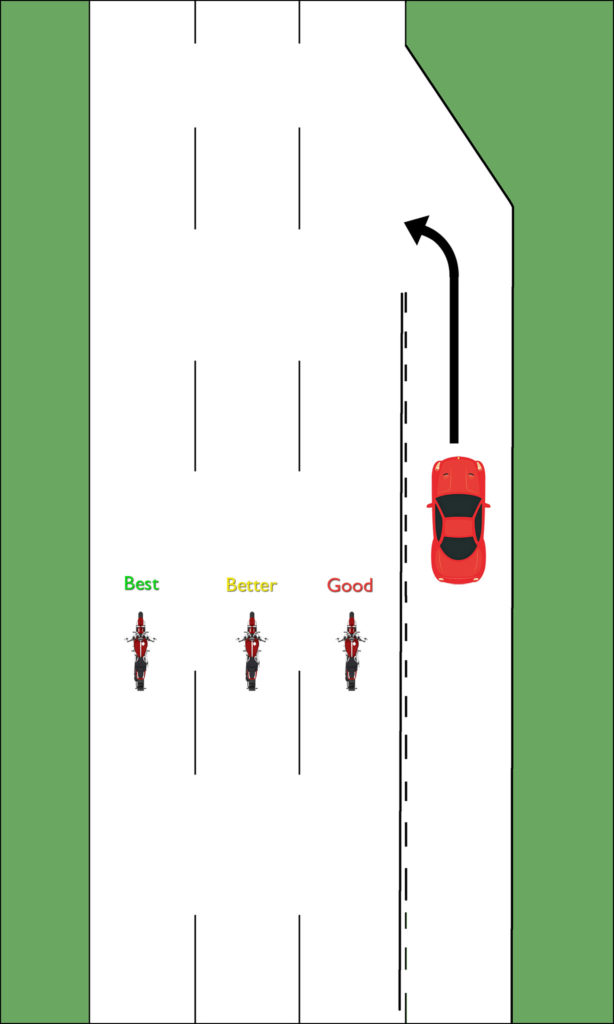
In the graphic above you see illustrated three possible choices you could make. The “Good” choice to make would be to remain in the right lane, roll off the throttle, cover your brake and allow the merging vehicle to take its position on the highway in front of you. Be ready for anything. I’ve said it before. Always assume that any vehicle you’re sharing the road with will do the stupidest possible thing that you can imagine they might do. They generally won’t let you down.
That vehicle may not be under the control of the most knowledgeable and confident driver on the planet. They may not accelerate as the ramp is designed to allow them to. They could even slow down. They might panic and stop completely. Be aware and be ready.
Better and Best
The “Better” and “Best” solutions are to take up a position away from the actual on ramp. Obviously these choices are dependent upon your ability to safely take a position in one of those lanes. This is why you were instructed to assess what is going on around you as you approach the on ramp. Know where you stand. Know what your options are. Choose the best option BEFORE a problem presents itself.
I generally move to the center or left lane every time I approach an on ramp whether I see a vehicle on the ramp or not. Vehicles can appear on ramps quickly. Especially on older highways that are not built to Interstate specifications. Some of these older highways have very short acceleration lane on ramps with “blind” approaches. On-bound vehicles can appear quickly! There are many of these older roads in my native New York where the Parkways were designed 50, 60 or even 70 years ago. When you approach any on ramp, safely take your place in the “Better” or “Best” positions as shown in the diagram above.
Off Ramps
Off ramps are highway hazards to motorcycles as much as on ramps. Maybe more so. When approaching an off ramp be ready for anything. The most likely hazard you’ll encounter is another vehicle who is about to miss making his exit.
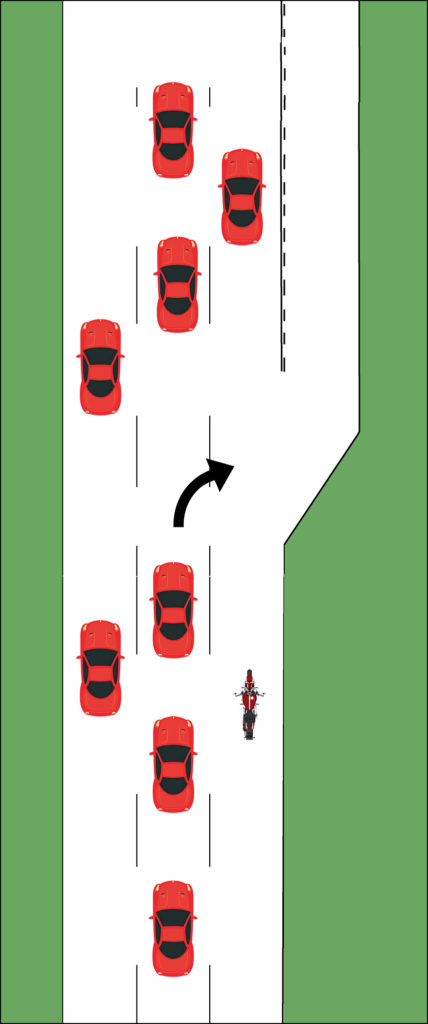
The most likely result is pictured in the graphic above. The vehicle will make a last-minute move to exit the highway. They most likely will not see you approaching from behind, or will pay you no heed. Be ready for this possible scenario. They will cross right into your path of travel…often while braking at the same time! Give them the room they need; even if you don’t think they deserve that courtesy. Any alternative choice has the potential to be deadly. Remember what has been said earlier: When a motorcycle goes one-on-one with another vehicle the motorcycle always loses! Period. End of story. It doesn’t matter who is at fault. It doesn’t matter who had the right of way. The motorcycle loses!
High Profile Vehicles

One of the greatest highway hazards to motorcycles is the fact that you’ll be sharing the road with a lot of high profile vehicles. Large trucks, buses, tractor-trailer rigs, etc. On the Interstate system, in particular, these vehicles often outnumber the passenger cars on the road. They pose potential dangers for a number of reasons. First and foremost is visibility. Their’s and yours.
It should go without saying that one should not ride too close to the back of a large profile vehicle. It would go without saying if I haven’t seen so many motorcyclists doing so. Lay back…especially at highway speeds. As stated in the previous post you should have a good view of what’s going on 12-15 seconds ahead of you at all times. Sorry. You just can’t make that happen when you’re staring closely at the back of a tractor trailer rig.

There is no good reason, and a thousand bad ones, for taking a position close behind a high profile vehicle. I’ve seen stubborn motorcyclists try to “hold their ground” when other vehicles attempt to squeeze in between them and the truck in front of them. Let them have the dangerous spot. Why are you even trying to defend a dangerous position? Is it worth your life? Back off, take a deep breath and get a good view of the road ahead. You’ll get your opportunity to pass both vehicles soon enough…and on your high performance motorcycle you have what it takes to do so safely in a commanding fashion.
Blind Spots
High profile vehicles have unique and expansive blind spots. I’m sure you’re all familiar with that warning sign that is posted on the back end of many high profile vehicles. It states: “If you can’t see my mirrors, I can’t see you.” Simple enough and quite true.
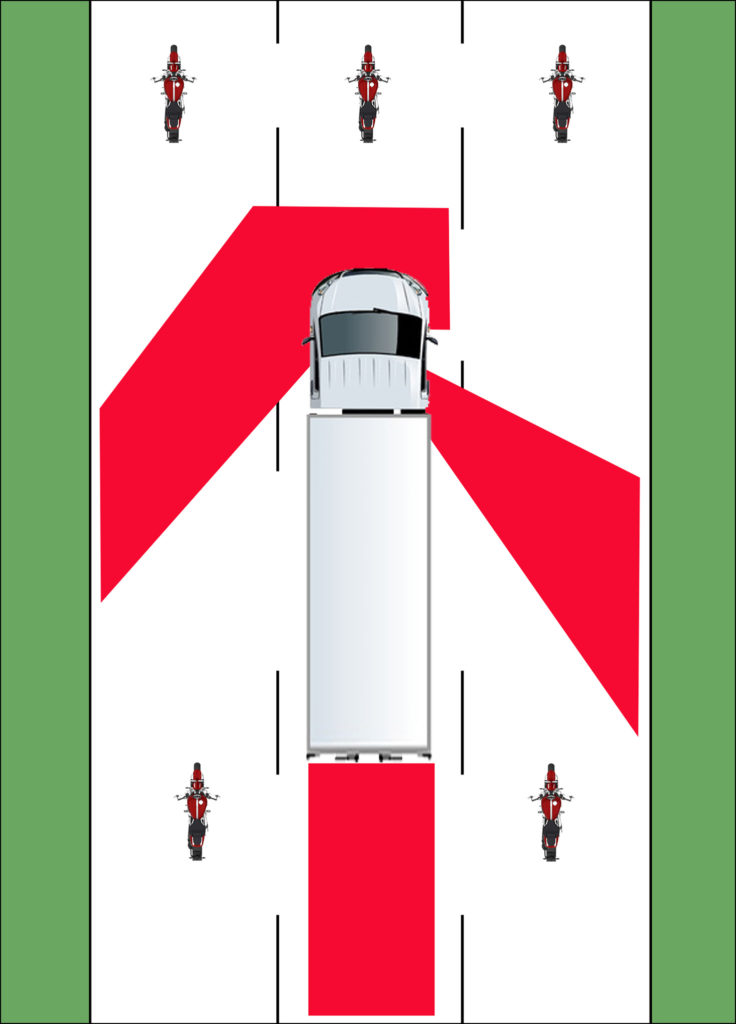
Take a good long look at the graphic above. Those red areas are danger zones. The driver of that semi or bus can’t see you if you are riding in any one of those red zones. Don’t! If you’re coming up from behind with the intention of passing the vehicle, do so quickly. Spend as little time as is physically possible in the red zone. Professional drivers tend to be more observant than your average highway traveler, but it’s up to you to give them a fighting chance of seeing you.
Take a look at that red area in front of the truck as well. A lot of folks don’t give that blind spot much thought. Quite simply, the driver of that big semi can’t see out over the long, high hood of his tractor down to the pavement in front of the vehicle. Don’t ride there…ever! Being rear-ended by a truck or bus won’t turn out well.
Wind Turbulence
Another one of those highway hazards to motorcycles to consider when sharing the road with high profile vehicles is the wind turbulence that they generate as they move down the highway. Those huge vehicles push an equally huge amount of air around. Most of it is dispersed in a cone-shaped area around the vehicle as pictured in the graphic below.
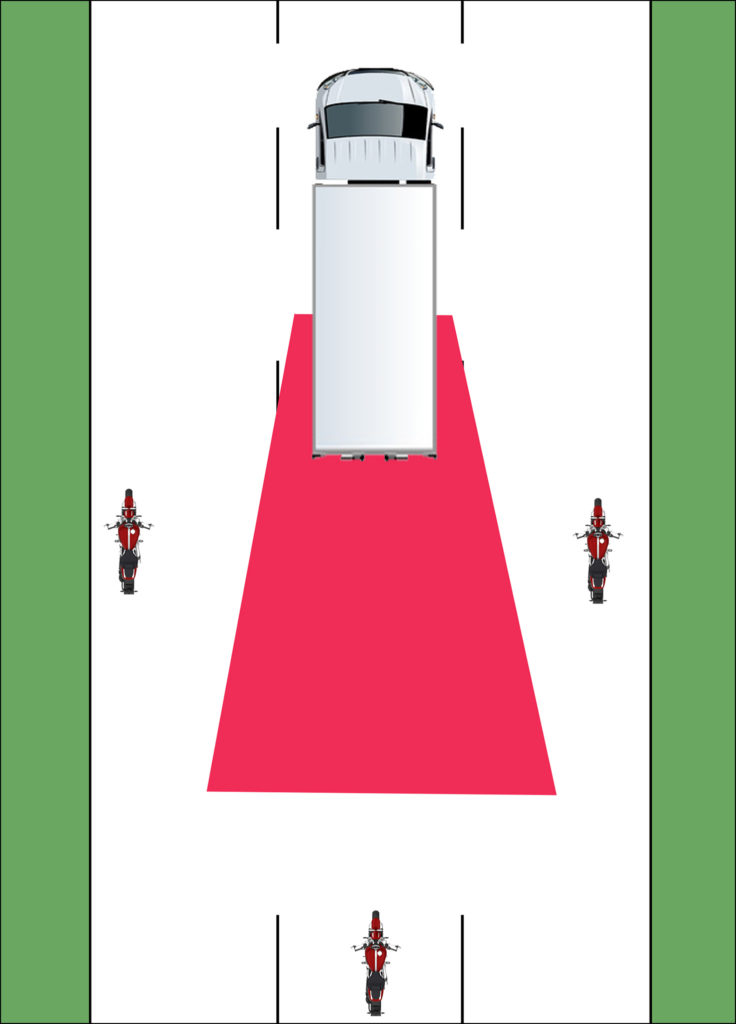
This turbulence is enough to effect the handling of the otherwise stable two-wheeled platform you’re riding on. If you’re approaching the vehicle with the purpose of passing it, be aware that you’re going to feel a large blast of turbulence that may require your countersteering input to the handlebars.
The same holds true if the high profile vehicle passes you. You will feel that blast of wind as the truck passes, and may have to apply some steering input to the motorcycle to compensate. In either scenario (passing or being passed) you should assume a position as far apart from the vehicle as possible. Those positions are shown in the graphic above.
A third position, behind the truck, is also shown. If you find yourself following a high profile vehicle, with no intention of passing it, you’ll do well to hang back a little bit. A large area of turbulence exists directly behind the vehicle and you won’t want to be riding in it. Trust me…you’ll figure out very quickly the distance at which you will be comfortable following. It happens to coincide with where you should be for appropriate viewing of the road ahead. How convenient!
Other Highway Hazards To Motorcycles
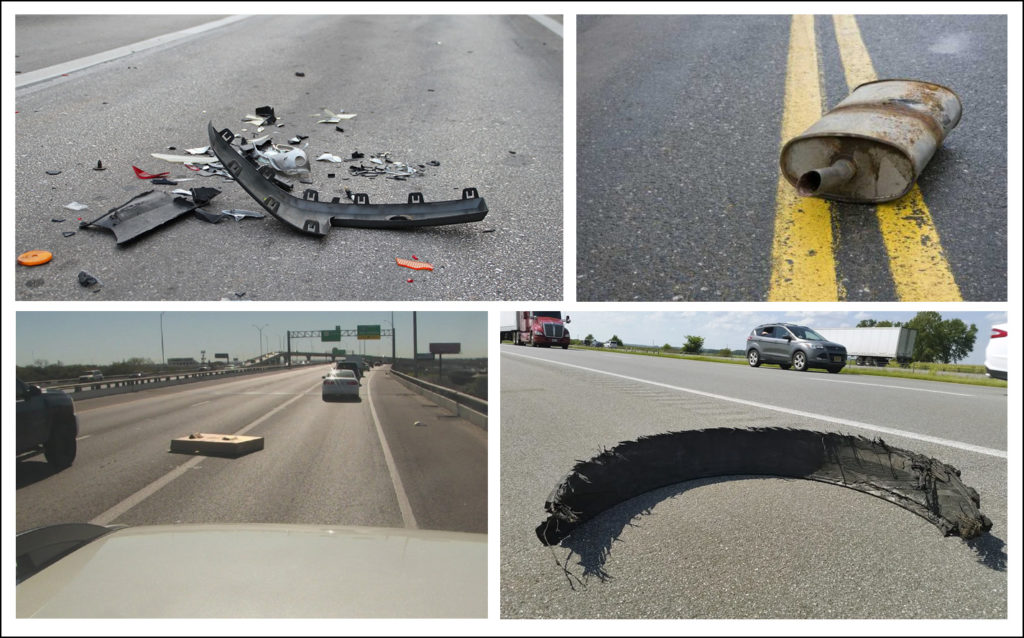
The images above are just a small taste of road hazards you’re likely to encounter on roadways. I’ve said more than once that “Things that are a mere annoyance to automobiles can be deadly to motorcyclists.” Certainly some of the debris we encounter lying out on the road can be considered among highway hazards to motorcycles.
I can’t even remember all the things I’ve found lying in the middle of the road over the years. Dead, (and live), wildlife. An old mattress. A sofa. A canoe. Thousands of fresh-picked ripe oranges squashed into an incredibly slippery pulp. Random fragments of building materials. A misplaced manhole cover or two. In nearly four decades of riding I’d like to think I’ve seen it all. Sadly, I know that is not true. I’m surely destined to see something really surprising the longer I remain in the saddle.
The trick is not to hit this stuff. And the trick to that is seeing it! The graphic below shows the best way to making that happen. Once again it comes down to one word: visibility.
Position Yourself For Success
Most motorcyclists that have fallen victim to road hazards offer the same excuse. “I didn’t see it until it was too late.” This begs the question: “Why not?” Did they, as riders, do everything within their power to stack the odds in favor of seeing the hazard before they struck it?
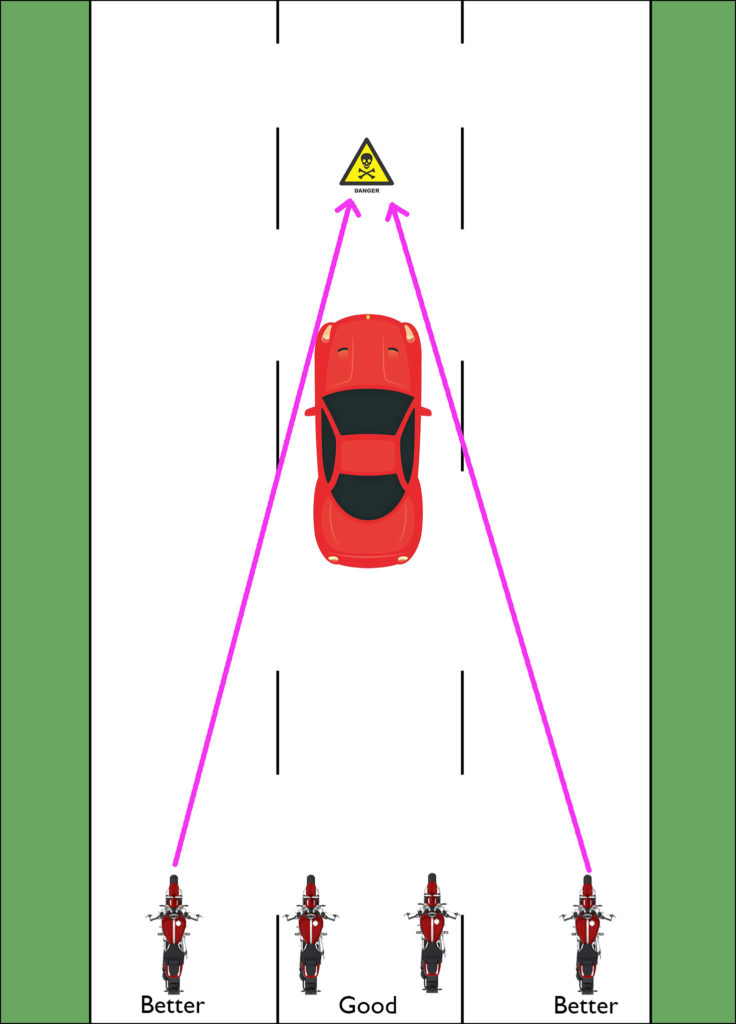
The graphic above illustrates the best position(s) to assume to maximize your visibility of the road ahead. Under perfect conditions you would be positioned in either the left lane or right lane, so that the vehicle in front is not blocking your view of the pavement ahead. Any potential road hazards should be visible to you from either of these positions.
If you find yourself ‘trapped’ behind another vehicle (in dense traffic, for example) you should assume a position in either the left hand or right hand track of the traffic lane. Watch the movement of the vehicle in front of you carefully. Hopefully that driver will spot any upcoming road hazard and make the appropriate evasive move to avoid striking it. Chances are the driver will “straddle” the hazard. If you’re following in the center track you will strike the hazard. If you’re off to one of the side tracks, as suggested; you stand a much better chance of avoiding a dangerous encounter.
By the way, this positioning strategy is one that should be employed during around town riding and on secondary roads as well. The appearance of weird road debris items isn’t exclusive to major highways. You’re going to find it on all types of roads everywhere.
Conclusion
That will wrap it up for today’s installment of highway hazards to motorcycles. In the next episodes we’ll be discussing some other issues that will confront you out on the highways. Riding in strong wind, dense traffic jams, lane splitting/filtering and road rage are a few of the topics we’ll be discussing. As always we welcome your comments below. We’d especially like to hear about some of the strangest road debris hazards you’ve encountered in your travels. Be sure to subscribe to Roadcraft USA for occasional email notifications when new features hit the blog.
Click Here to view an interactive visual index page where you can quickly browse through all of the great features that are published on the Roadcraft USA blog.


Last week I was riding on I40 in Arizona behind a tractor trailer when I hear what sounded like a shotgun blast but it was a tire from the truck but I was far enough behind to avoid a 3ft piece of rubber coming my way and was able to quickly get in the left lane and slow down enough to avoid more rubber. I was also lucky no other vehicles close by or I my not be sitting here telling my story. I think someone was watching over me. Just something else to be aware of when traveling on the interstate.
Scary scenario, Steve. Glad you’re still here to share it with us. Yes…those “Road Alligators” left on the pavement after disintegrating from recapped tires are a common hazard. We even pictured one in the post. Thanks for commenting!